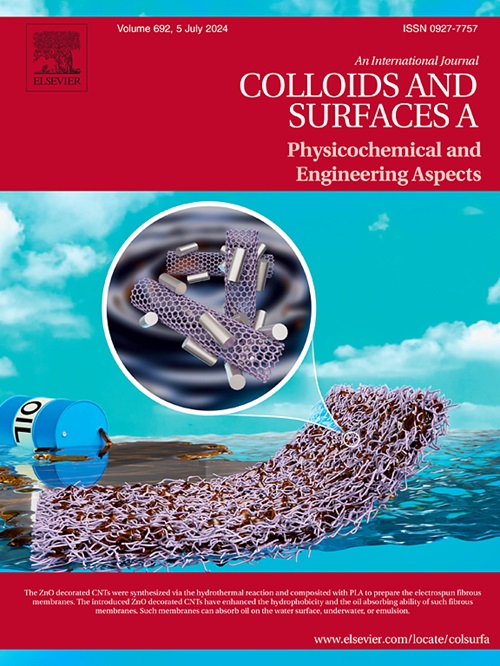Towards reproducible wetting studies: Automated contact angle determination by molecular simulations
IF 4.9
2区 化学
Q2 CHEMISTRY, PHYSICAL
Colloids and Surfaces A: Physicochemical and Engineering Aspects
Pub Date : 2025-07-10
DOI:10.1016/j.colsurfa.2025.137586
引用次数: 0
Abstract
Accurate determination of contact angles in molecular modeling traditionally requires manual intervention and parameter tuning, which limits reproducibility and efficiency. In this paper, we present PANDA-NN, a fully automated pipeline that determines liquid–liquid–solid contact angles. Our method uses a PointNet++ neural network to classify the shapes of interfacial boundaries between immiscible liquids in a slit pore, allowing us to automatically select the appropriate analytical equation to describe the density profile. Interfacial shape classification achieves robust performance across all classes: the confidence of the model in surface type classification of MD systems was greater than 99%. Then we use gradient optimization procedure to calculate the angle by minimizing the difference between simulated and theoretical density profiles. Molecular dynamics simulations demonstrate the high precision of the presented method (mean absolute percentage error2°) without manual pre-processing. PANDA-NN improves the reproducibility of nanoscale wetting studies by eliminating operator bias, and facilitates investigations of interfacial phenomena. This provides researchers with a robust tool to quantify molecular wetting with a high level of automation, potentially accelerating materials discovery for applications ranging from enhanced oil recovery to microfluidic device development.

可重复润湿研究:通过分子模拟自动确定接触角
传统的分子建模中接触角的精确测定需要人工干预和参数调整,这限制了再现性和效率。在本文中,我们提出了PANDA-NN,这是一个全自动的管道,可以确定液-液-固接触角。我们的方法使用PointNet++神经网络对狭缝孔隙中不混相液体之间的界面边界形状进行分类,使我们能够自动选择合适的解析方程来描述密度分布。界面形状分类在所有类别中都具有鲁棒性:该模型在MD系统表面类型分类中的置信度大于99%。然后利用梯度优化程序,通过最小化模拟密度曲线与理论密度曲线之间的差异来计算角度。分子动力学模拟证明了该方法的高精度(平均绝对百分比误差<;2°),无需人工预处理。PANDA-NN通过消除操作偏差提高了纳米尺度润湿研究的可重复性,并促进了界面现象的研究。这为研究人员提供了一个强大的工具,以高水平的自动化来量化分子润湿,潜在地加速了从提高石油采收率到微流体装置开发等应用的材料发现。
本文章由计算机程序翻译,如有差异,请以英文原文为准。
求助全文
约1分钟内获得全文
求助全文
来源期刊
CiteScore
8.70
自引率
9.60%
发文量
2421
审稿时长
56 days
期刊介绍:
Colloids and Surfaces A: Physicochemical and Engineering Aspects is an international journal devoted to the science underlying applications of colloids and interfacial phenomena.
The journal aims at publishing high quality research papers featuring new materials or new insights into the role of colloid and interface science in (for example) food, energy, minerals processing, pharmaceuticals or the environment.

 求助内容:
求助内容: 应助结果提醒方式:
应助结果提醒方式:


